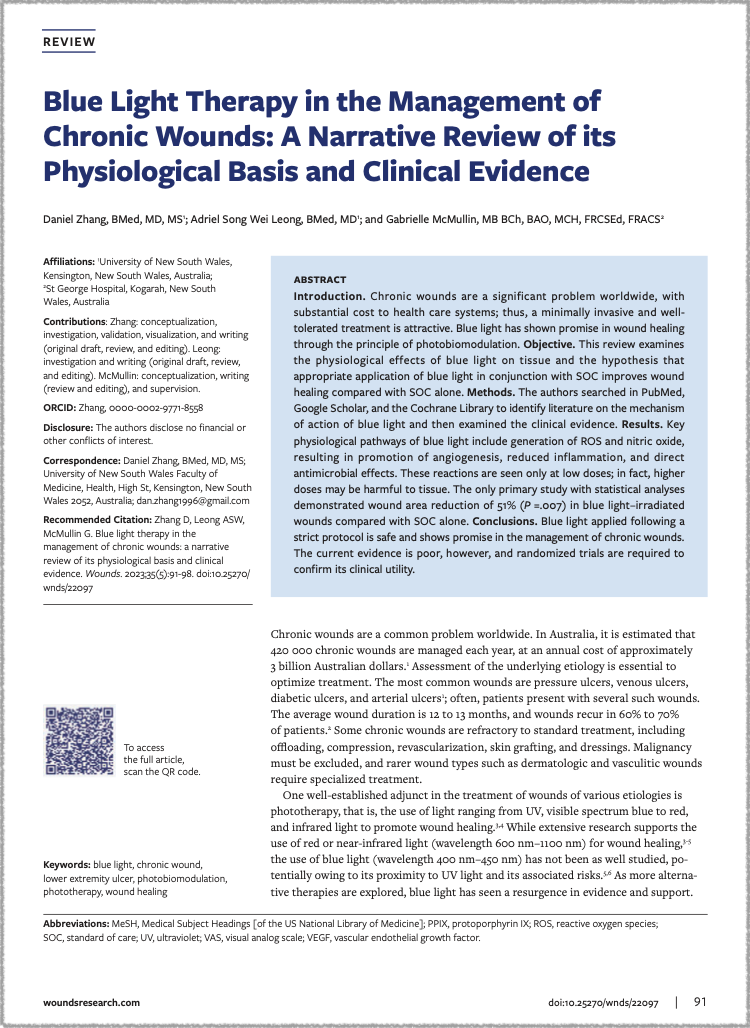
Blue Light therapy for chronic wounds
A review of the scientific litterature
Authors: Zhang D, Leong ASW, McMullin G
Title: Blue light therapy in the management of chronic wounds: a narrative review of its physiological basis and clinical evidence
Year: 2023
Publication: Wounds. 2023 May;35(5):91-98. doi: 10.25270/wnds/22097.
SUMMARY
The review examines the physiological effects of blue light on tissue and the hypothesis that appropriate application of blue light in conjunction with standard of care (SOC) improves wound healing compared with SOC alone.
The authors searched in PubMed, Google Scholar, and the Cochrane Library to identify literature on the mechanism of action of blue light and then examined the clinical evidence.
Key physiological pathways of blue light include generation of ROS and nitric oxide. In summary, it is believed that through increased local ROS and nitric oxide, improved wound healing occurs as the result of improved local perfusion via angiogenesis, with secondary benefits of improved re-epithelialization and reduced inflammation through ROS regulation and signaling. These reactions are seen only at low doses; in fact, higher doses may be harmful to tissue.
Reservations remain about the use of blue light owing to its proximity to UV light in terms of wavelength and the potential for the DNA damage commonly attributed to UV light. Compared with blue light, UV light has a greater propensity to cause DNA damage. Although both UV and blue light therapy have antimicrobial properties, those of UV light and its direct actions on DNA are much more potent, such that UV sterilization is commonplace in medicine and in the food industry. However, blue light can cause oxidative DNA damage in a dose-dependent manner.
The safe use of blue light requires the use of an easily controlled, precise device that emits a narrow-band wavelength within the visible blue light spectrum at a set fluence and adherence to strict protocols regarding duration of illumination to reach the therapeutic threshold and not extend beyond that into toxicity.
5 studies were identified for inclusion in the review: 4 case series (Khoo et al, 2021 – Marchelli et al, 2019 – Nair and Sulong, 2021 – Aliquò et al, 2021 – Dini et al, 2021) and 1 controlled study (Fraccalvieri et al, 2021). Clinical evidence suggests that blue light in conjunction with SOC (including dressings and compression) has a real benefit in improving the rate of wound healing. In the studies included in the review, no adverse effects were reported during treatment and the application of blue light was well tolerated. However, long-term follow-up was generally lacking in these studies.
The physiological basis of improved wound healing appears to be independent of wound etiology, as indicated by the literature, with all common types of chronic leg ulcers demonstrating improved wound healing after blue light therapy. However, the quality of the evidence is poor, consisting mostly of case series with observational data and only 1 “controlled” study.
With more robust evidence supporting its use, the authors anticipate that blue light will be an attractive option as an adjunct to SOC for wounds. Blue light therapy has clear treatment protocols that are noninvasive, well tolerated, minimally time-consuming, and easily standardized with minimal training.

